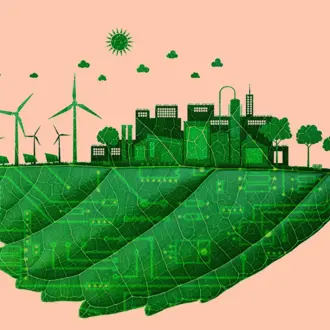Credit: bestdesigns | iStock
Climate Change
New perspectives on understanding, preventing, and preparing for climate change
"Climate Future: Averting and Adapting to Climate Change," by MIT Sloan economist Robert S. Pindyck explains what we know and don’t know about climate change, and what we can do to prepare for a possible climate catastrophe.
CAMBRIDGE, Mass., Jan. 17, 2023—A new book by an economist at MIT Sloan School of Management argues that despite efforts to reduce emissions worldwide, severe climate change is likely inevitable in the not-too-distant future and we must invest now in strategies and technologies to help us adapt to rising temperatures and sea levels.
“Given the economic and political realities, it’s simply not realistic to expect emission reductions alone will avert global warming," says author the Bank of Tokyo-Mitsubishi Professor of Economics and Finance. He says federal, state, and local governments need to invest in adaptations to counter current and future fallout from climate change.
Exactly how much will temperatures and sea levels rise, and how will this impact our economic and social welfare? Pindyck says it’s impossible to know. “The extent of climate change and its impact on the economy and society are much more uncertain than most people think,” he writes.
In Climate Future: Averting and Adapting to Climate Change, Pindyck argues that despite our best efforts, there’s “a strong likelihood” global mean temperature over the next 50 years will increase 3 degrees Celsius or more due to the rapid growth of emissions from China, India, and other developing countries.
These increased emissions, Pindyck notes, have "completely swamped" the relatively small emission reductions achieved in the U.S. and Europe. Even if worldwide emissions went to zero today, atmospheric CO2 concentrations would remain above 400 ppm for decades to come because of the two-decade or more lag between an increase in atmospheric CO2 and the related effect on temperature.
This means that in addition to reducing greenhouse gas emissions, we need to develop new hybrid crops, adopt policies to discourage building in flood-prone or wildfire-prone areas, build seawalls and dikes–among other approaches–to counter the effects of rising sea levels, extended drought, and more intense and frequent storms.
Throughout history, migrating populations have successfully adapted to changing conditions through human innovation. The Netherlands’ earliest dikes, for example, were built more than 800 years ago. Pindyck, who has studied the economic and policy implications of global catastrophic events such as the COVID-19 pandemic, says we need to work now to avoid the worst effects of climate change.
Among his recommendations:
- Stop government insurance programs that subsidize the construction of homes and businesses in flood-prone and wildfire-prone areas
- Change building codes to reduce vulnerability to flooding
- Build more levees and seawalls, which already protect around 15 percent of the U.S. coastline from erosion, rising sea levels, and the effects of hurricanes
- Pursue solar geoengineering, which aims to reflect solar energy back into space to cool the planet
- Protect and enhance natural barriers to flooding such as coastal wetlands, dunes, coral reefs, and maritime vegetation
- Develop new heat- and drought-resistant crops
- Plant more trees and continue to pursue carbon sequestration technologies
- Pursue nuclear energy as well as renewables
Pindyck argues that while the U.S. and Europe may meet CO2 emission targets, China, India, Indonesia, and Russia most likely will not, and may not even set targets. “Even the most optimistic projections of CO2 emission reductions imply a substantial buildup of CO2 in the atmosphere, and as a result a gradual increase in temperatures worldwide,” he says.
“Maybe the impact of higher temperatures and rising sea levels on GDP and other measures of human welfare over the coming decades will be small,” he writes. “Or maybe we’ll be very unlucky, and the impact will be extreme.” We simply cannot know, he says, because while predictive models convey an aura of scientific legitimacy and precision, climate systems are inherently complex and beyond our current ability to predict with a high level of accuracy, he says.
This level of uncertainty can make public policy decision-making confounding. Because today's climate policy decisions have both short-term costs and long-term economic implications, it would be wrong to take a "wait-and-see" approach. Pindyck, whose research spans microeconomics and industrial organization, natural resource, and commodity markets, considers it "irresponsible to make believe" that relying on GHG emission reductions alone will avert a climate catastrophe.
About the MIT Sloan School of Management
The MIT Sloan School of Management is where smart, independent leaders come together to solve problems, create new organizations, and improve the world. Learn more at mitsloan.mit.edu.



